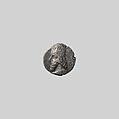Drachm
Not on view
Numismatists – the scholars who study coins – refer to the ‘front’ side of the coin, which usually features the head of a person or god, as the ‘obverse,’ and the ‘back’ side as the ‘reverse.’
On the obverse of this silver coin, a bust of the king faces to the left. He has a long beard and a large nose, and he wears a domed hat with earflaps (called a ‘tiara’) with a diadem (the headband worn by victorious athletes in ancient Greece) tied over it. The tiara is decorated with three semicircles of dots around a crescent. He wears a necklace or torque around his neck.
The reverse shows a figure facing left standing before an altar with a round flame emerging from the top of it. The figure carries a long, thin object, usually interpreted as a Zoroastrian ritual implement called a ‘barsom.’ A Persian inscription, reading "King Darev, son of King Vadfradad," surrounds the image.
This coin was minted by King Darev II of Persis, called Darius in Greek, sometime in the first century B.C. Persis refers to a region in southwestern Iran which was the heartland of the Achaemenid Empire. Under the Seleucids and Parthians, Persis was ruled by client kings like Darev, who combined elements of Achaemenid, Seleucid and Parthian iconography on their coins. The diadem worn by Darev, for example, is a common feature on images of Seleucid kings. The fire altar on the reverse is an important part of Zoroastrian religious practice, suggesting that the kings of Persis in this period actively promoted this religion.
This coin was excavated at Qasr-i Abu Nasr, near Shiraz. Much of the material from the site dates to the Sasanian period (A.D. 224-651); this coin is one the few objects suggesting it was occupied in the Parthian period as well.
Due to rights restrictions, this image cannot be enlarged, viewed at full screen, or downloaded.
This artwork is meant to be viewed from right to left. Scroll left to view more.



